
James Webb Space Telescope's first images of Mars, captured by its Near-Infrared Camera (right), and a reference map (left), detail. Photo Credit: Courtesy of NASA, ESA, CSA, STScI, Mars JWST/GTO team
Technology USARed Planet Shows Its Colors (Giving Us a Chance to See Any Sign of Ex-Life)
NASA’s James Webb Space Telescope took pictures of the sunny side of our closest cosmic neighbor, Mars, and of its entire spectra of colors – to help astrophysicists better understand seasonal changes, weather, and sandstorms on the Red Planet – as well as any potential life in its past.
“The fact that, when we opened the images and when we got the spectra, we actually could get the data and they were good data, it was exciting,” explains Sara Faggi, an astrophysicist working on the project for NASA.
The James Webb Space Telescope is designed to capture even the faintest light, and from its current position – 1.6 million kilometers away from Earth – it managed to capture its first images of Mars. The images captured by Webb’s Near-Infrared Camera (NIRCam) at two different wavelengths allowed scientists to see Mars’s eastern hemisphere, the variations in temperature at different latitudes and times of day, and “the subtle variations in brightness between hundreds of different wavelengths representative of the planet as a whole,” per NASA. The telescope could also help astronomers look for chemical compounds like hydrogen chloride and methane, the latter being a potential marker for a past life that has yet to be confirmed by other instruments.



